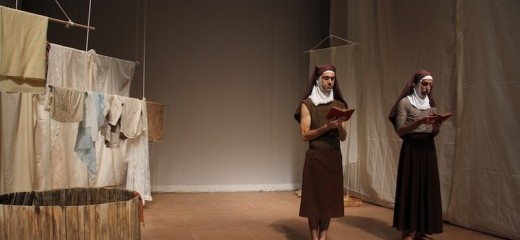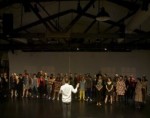
The Creeping Threat of Time
by Julius Ferraro
Three tall walls dramatically cut down the broad playing space at FringeArts, leaving a narrow, vertical tunnel down which light streams from above. The walls are draped with off-white sheets, and the white light cast against them feels natural and cool. Wooden dowels hang from long ropes to act as laundry lines, dropping with lazy gravity. Andrew Thompson’s simple and gorgeous design for No Face Performance Group’s Abbot Adam: None creates a peaceful, almost monotone aesthetic.
A few isolated giggles greet Jaime Maseda’s entrance in a nun’s habit and coarse wool gown. She moves deliberately, sits, and begins to fold laundry. When Mark McCloughan joins Jaime, also dressed as a nun, and they discuss their arid day in the cloister, there are more snickers among the mildly inebriated FringeArts audience, but these are not encouraged, and they soon stop.
This is a drag show, but this is not that drag show. The life of these cloistered nuns is excruciatingly slow. They fold laundry, tell gentle jokes, and have incidental conversation, as long pauses crystalize with contemplation. The nuns take off their clothes, exposing their male genitals, and wash peacefully in a wooden basin, smiling with pleasure at the contact of the water.
“The night never ends,” says one. “Neither does the afternoon,” responds the other. Their faces generally repress emotional response. After his bath, one says, “I should fold these,” referring to laundry still hanging. The other gently rebukes him: “Enjoy the hour.”
Time is an existential threat, and in 2015, our relationship with time, and empty time in particular, is more antagonistic than it ever has been. Our fractured consciousness is both enriched and overstimulated by ready access to distraction and easy entertainment, leaving us more easily dismayed by boredom and oftentimes alienated by contemplation.
A whole genre of “durational” theater and art—I wrote an article about durational performance for The Smart Set last year—has surfaced in the last fifty years to address, among other things, our shortening attention spans. Unusually long performances or videos, like Andy Warhol’s Empire and Philip Glass and Robert Wilson’s Einstein on the Beach, question art’s responsibility to entertain and they demand that viewers confront their own sense of time. At 75 minutes, None is shorter than most durational work (the Marina Abramovic Institute defines “durational” as lasting six hours or more), but it manages to make the passing of time and its latent threats felt. I, viewing it, must continually give myself over to the experience of watching. My boredom and frustration surface and resurface, followed by confusion.
About 40 minutes into the play, a grating audio drone grinds slowly to a deafening volume. The nuns, who have been lying on the floor, raise themselves up by pressing against one another, stretching their arms out, slowly kicking their toes against the ground, and then fall.
Maseda and McCloughan struggle to stand, ball up the laundry, change their costumes, take down hanging sheets. The rich environment which so placidly expressed the nuns’ daily life unravels. Maseda, now in green overalls, approaches the front of the stage and begins a speech. The lights dim after he begins, and a spotlight swings onto him even after that. “I am a stableboy,” he begins in a monotone and a stiff scowl. He describes a life of constant work; when the job is well done and the horses are well fed, he claims without a smile, “This is my joy.”
His experience of “joy” is as alien to me as the nuns’ toil: devotion and achievement almost completely without self-indulgence, and with no smile.
But I can’t help asking, what happened to the nuns? The introduction of the stableboy and complete erasure of the previous set triangulates one of the play’s themes, duration. But it feels like sleight of hand, slipping important questions of presence and gender out of sight. I cannot answer the question of why Maseda and McCloughan are playing women, why they choose to show their genitals, and why they become men in the final moments.
About two thirds of the way through the play, in a particularly still moment, one of the laundry lines slowly rises about three feet and then stops. This process grabs the audience’s attention. The shift makes no conceivable difference in the picture of the set or the environment in the play, nor does it mark a dramatic shift. This is maybe the only joke in the entire play, and it’s a joke on the audience. We are reminded, in a purely theatrical bit of trickery, how influenced we are by slowness, and how adept these artists are at manipulating it.
Abbott Adam: None, No Face Performance Group, FringeArts, Dec. 10-12.
By Julius Ferraro
December 21, 2015




.png)


